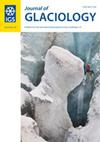在南极洲乔治六世冰架上观察到的融水引起的挠曲和断裂
IF 2.6
3区 地球科学
Q2 GEOGRAPHY, PHYSICAL
引用次数: 0
摘要
全球导航卫星系统(GNSS)观测数据与在创纪录的 2019/2020 年融化季节获得的地面延时摄影相结合,描述了南极洲乔治六世冰架上先前形成的多林的挠曲和断裂行为特征。全球导航卫星系统时间序列显示,在中央融水湖的荷载作用下,穹隆中心相对于穹隆边缘向下垂直位移约 60 厘米。全球导航卫星系统的数据还显示,在十几天的时间里,水平位移快速发生,并呈指数衰减,在这段时间里,穹隆边缘与其中心之间的水平距离增加了约 70 厘米。我们将这一事件解释为断裂的开始和/或扩大,与多林盆地融水负荷相关的应力扰动起到了辅助作用。粘性挠曲模型表明,融水荷载产生的拉伸表面应力超过 75 千帕。这与我们拍摄的多林周围环形断裂的延时照片一起,首次证明了融水荷载在冰架上引起的 "环形断裂 "的形成,这与 2002 年拉森 B 冰架断裂时提出的链式反应湖排水过程中的断裂类型相同。本文章由计算机程序翻译,如有差异,请以英文原文为准。
Observed meltwater-induced flexure and fracture at a doline on George VI Ice Shelf, Antarctica
Global Navigation Satellite System (GNSS) observations and ground-based timelapse photography obtained over the record-high 2019/2020 melt season are combined to characterise the flexure and fracture behaviour of a previously formed doline on George VI Ice Shelf, Antarctica. The GNSS timeseries shows a downward vertical displacement of the doline centre with respect to the doline rim of ~60 cm in response to loading from a central meltwater lake. The GNSS data also show a tens-of-days episode of rapid-onset, exponentially decaying horizontal displacement, where the horizontal distance between the doline rim and its centre increases by ~70 cm. We interpret this event as the initiation and/or widening of a fracture, aided by stress perturbations associated with meltwater loading in the doline basin. Viscous flexure modelling indicates that the meltwater loading generates tensile surface stresses exceeding 75 kPa. This, together with our timelapse photos of circular fractures around the doline, suggests the first such documentation of meltwater-loading-induced ‘ring fracture’ formation on an ice shelf, equivalent to the fracture type proposed as part of the chain-reaction lake drainage process involved in the 2002 breakup of the Larsen B Ice Shelf.
求助全文
通过发布文献求助,成功后即可免费获取论文全文。
去求助
来源期刊

Journal of Glaciology
地学-地球科学综合
CiteScore
5.80
自引率
14.70%
发文量
101
审稿时长
6 months
期刊介绍:
Journal of Glaciology publishes original scientific articles and letters in any aspect of glaciology- the study of ice. Studies of natural, artificial, and extraterrestrial ice and snow, as well as interactions between ice, snow and the atmospheric, oceanic and subglacial environment are all eligible. They may be based on field work, remote sensing, laboratory investigations, theoretical analysis or numerical modelling, or may report on newly developed glaciological instruments. Subjects covered recently in the Journal have included palaeoclimatology and the chemistry of the atmosphere as revealed in ice cores; theoretical and applied physics and chemistry of ice; the dynamics of glaciers and ice sheets, and changes in their extent and mass under climatic forcing; glacier energy balances at all scales; glacial landforms, and glaciers as geomorphic agents; snow science in all its aspects; ice as a host for surface and subglacial ecosystems; sea ice, icebergs and lake ice; and avalanche dynamics and other glacial hazards to human activity. Studies of permafrost and of ice in the Earth’s atmosphere are also within the domain of the Journal, as are interdisciplinary applications to engineering, biological, and social sciences, and studies in the history of glaciology.
 求助内容:
求助内容: 应助结果提醒方式:
应助结果提醒方式:


